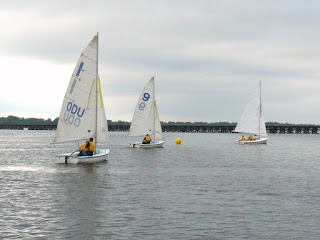.
First of all, it's is so easy to make a sailboat MOVE that you can't -not- do it. The dadgum boats are always moving... rocking, tipping, sliding sideways, drifting downwind, or drifting with the current (or some combination of all the above).
 The question is, how do you make a sailboat move in the direction you want it to?
The question is, how do you make a sailboat move in the direction you want it to?This can seem easy when everything is going right, and impossible when things won't go right. That's where knowledge and skill come into the equation... a good sailor will get their boat going right when it seems every factor is against them.
The best thing to do as a beginner: memorize this diagram. We're not kidding!
A sailboat will make progress... or not... according to the Point of Sail which it's on. This is determined by the direction of the wind relative to the direction the boat is headed. As you can see in the diagram, the closer the boat is angled to the wind, the tighter the sails are pulled in.
.
Here is a beginner sailor that needs some help figuring this out. He is stuck "in irons" and the boat will not move forward.
Unfortunately the coach is taking a nap.
.
These sailors have it figured out... it doesn't hurt that the coach is actually coaching, too!
 The first key is to STEER the boat at a consistent angle to the wind. In this diagram, approximately a "beam reach" as determined by the coach who is flying the L flag ("Lima" means 'come here' or in this case 'follow me').
The first key is to STEER the boat at a consistent angle to the wind. In this diagram, approximately a "beam reach" as determined by the coach who is flying the L flag ("Lima" means 'come here' or in this case 'follow me').In this diagram, you can see the little red yarn on each boat's standing rigging which helps give the skipper a clue about wind direction, and thus which way to steer.
What should the first boat in line do? (hint- something involving the "MAIN SHEET")
.
 Here are two boats that need help. They have it almost figured out, at least they are not trying to steer straight into the wind. If they pulled their sails in -really- tight, they may be able to get moving.
Here are two boats that need help. They have it almost figured out, at least they are not trying to steer straight into the wind. If they pulled their sails in -really- tight, they may be able to get moving.What would happen if they pulled their JIBs in really extra-tight for a few moments?
Some people have a natural feel for being able to make a boat sail properly. For most, the first few times sailing are frustrating. These lessons attempt to put forth the basic skills needed to get a boat moving under sail, and to keep it under your command. You will need to know the beginner terminology (link) before you can get underway and try to make it work.
 What makes sailing difficult? First of all if it were easy, it would not be as much fun!
What makes sailing difficult? First of all if it were easy, it would not be as much fun!One factor which makes it difficult is that thing we mentioned at the beginning... boats are NEVER sitting still. Here we see two boats which are not sailing, not moving forward, but they are being pushed sideways by the wind. They are pointed in the direction of a BEAM REACH but the sails are not driving the boats forward. With no water flowing past the centerboard & rudder, the boats cannot be steered.
It does not matter which way you put the tiller if the boat is not moving forward! Furthermore, once the boat -IS- moving properly, holding the tiller straight does not guarantee that the boat will move straight forward. When we first get underway, we will try to make it easy for the beginners by playing "Baby Ducks" (link). The Baby Duck Drill is also fun for advanced sailors.
.
 .
.These beginners are getting it right... steering a constant angle to the wind (in this case, a BEAM REACH on STARBOARD TACK).
As long as the sails are making the boat move, we won't worry about whether to pull them in or let them out for precise aerodynamic efficiency
However, we will say two things about sail trim because steering is easy and it will be very soon that you will have to think and take action with the sails & sheets.
1- Basic rules to go by: flappy is not happy
.......................................when in doubt let it out
2- the boat with the most precise sail trim will go the fastest (assuming the steering is correct)
.
.













































